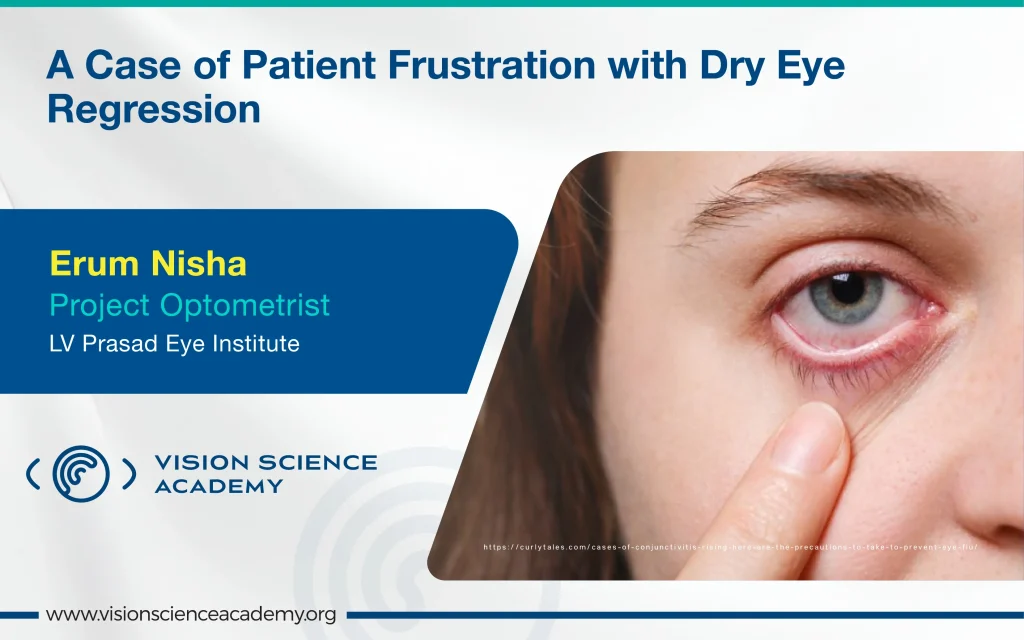Erum Nisha, B. Optom.
Project Optometrist, L V Prasad Eye Institute, Hyderabad, India
This is the case of a patient who came to the clinic after consulting three different doctors. The patient expressed dissatisfaction and discomfort, describing themselves as “very cranky”. They were seeking relief rather than a miracle cure. Previous treatments included artificial tear eye drops prescribed by one doctor, while another had recommended omega-3 supplements, oral doxycycline, and using hot compresses with a mask. (1,2)
Dry Eye Syndrome
Dry Eye Syndrome is a condition characterised by inadequate tear production, leading to redness, itching, heightened sensitivity to irritants, and a burning sensation in the eyes. It can stem from various causes, including allergies, infections, nervous system disruptions, ageing, or systemic diseases. Hormonal changes may make it more prevalent in women than in men. (1)
Symptoms can significantly impact daily activities, such as blinking rapidly or wearing contact lenses, and may be subtle, making diagnosis challenging. (2,3)
The patient presented with:
- Dry eye symptoms
- Suggestive findings on Schirmer test (< 5 mm wetting after 5 minutes) and Fluorescein Clearance Tests
- Fluorescein and Rose Bengal staining (> 3+), confirming clinical dry eye
Clinical Approach
The goal was to address the underlying condition of the patient, not just alleviate symptoms. The approach began by reviewing the symptoms, asking them to identify their primary concern in one word (e.g., itching, redness, discomfort, pain, watering, blurred vision, or difficulty with reading or computer use). This helped tailor the treatment to their most pressing issue.
A detailed history of prior treatments was taken, including:
- The type of artificial tears used (e.g., bottle cap description, gel or watery consistency, clear or white).
- Whether eye drop bottles were tightly sealed or left open for extended periods. (1)
- The consistency of omega-3 supplement intake.
Treatment Plan
The treatment plan includes the following components:
- Immunomodulatory Therapy: This will be prescribed even if it has been tried previously, but for a shorter duration.
- Artificial Tears and Gel: These are recommended to provide lubrication and relieve dryness.
- Hot Compresses: Instructions will be provided on the correct technique to ensure effective application.
- 20-20-20 Rule: This guideline encourages taking breaks during prolonged visual tasks, such as computer work, to reduce eye strain. Specifically, look at something 20 feet away for 20 seconds every 20 minutes.
- Follow-Up Appointment: A follow-up appointment is scheduled for one month to assess progress. (3,5)
Figure 1: Treatment Plan for Dry Eye Management.
Conclusion
After one month, the patient returned, reporting satisfaction and relief with the prescribed regimen. Managing Dry Eye Syndrome requires a comprehensive approach targeting both symptoms and underlying causes. For this patient with persistent symptoms, confirmed by clinical tests, a tailored treatment plan was developed. This included immunomodulatory therapy, artificial tears and gel, proper hot compress techniques, and adherence to the 20-20-20 rule. A thorough history of prior treatments informed the strategy, with a follow-up scheduled to monitor progress and adjust as needed, ultimately improving the patient’s comfort and quality of life. (4)
References
- Golden MI, Meyer JJ, Zeppieri M, Patel BC. Dry Eye Syndrome. In: StatPearls. Treasure Island (FL): StatPearls Publishing; February 29, 2024.
- Kaštelan S, Tomić M, Salopek-Rabatić J, Novak B. Diagnostic procedures and management of dry eye. Biomed Res Int. 2013;2013:309723. doi:10.1155/2013/309723
- Zemanová M. DRY EYE DISEASE. A REVIEW. SYNDROM SUCHÉHO OKA. přehled. Cesk Slov Oftalmol. 2021;77(3):107–119. doi:10.31348/2020/29
- Messmer EM. The pathophysiology, diagnosis, and treatment of dry eye disease. Dtsch Arztebl Int. 2015 Jan 30;112(5):71-81; quiz 82. doi: 10.3238/arztebl.2015.0071. PMID: 25686388; PMCID: PMC4335585.
- Sheppard J, Shen Lee B, Periman LM. Dry eye disease: identification and therapeutic strategies for primary care clinicians and clinical specialists. Ann Med. 2023 Dec;55(1):241-252. doi: 10.1080/07853890.2022.2157477. PMID: 36576348; PMCID: PMC9809411.
